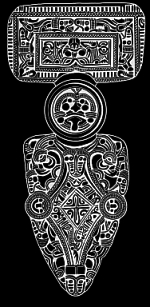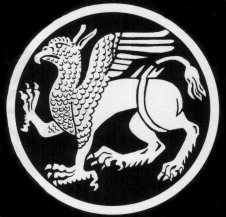 |



|
 |



|
Initially the music which forms the Beowulf orchestral suite was planned for an opera based on the life of the hero from the medieval epic poem of the same name. The operatic treatment, however, has been put on hold due to not yet having found a suitable libretto. The movements that comprise the present work were intended to be instrumental entr’actes within the larger opus itself, but for now they have been combined to form a suite that tells the story of our hero’s life without words.
Beowulf was composed in 2000 and originally was scored for ancient instruments. The score was reorchestrated for a modern ensemble in 2005. The instrumentation is for a standard orchestra with the brief additions of parts for organ and bagpipes.
The music is designed to convey a medieval flavor while incorporating modern harmonies for programmatic effect. Each movement presents a musical portrait of episodes from the epic tale. (N.B. The mp3s are of the Sibelius playback):
1. Præludium — Essentially an overture, the movement sets the stage for the events to follow.2. The Dedication of Heorot — King Hrothgar and his subjects parade to the dedication of his great mead-hall.
3. Grendel’s Journey Across the Moor — From his dark and foreboding lair, the monster Grendel hears the sounds of joy emanating from the mead-hall and makes his way to wreak destruction on the people of Hrothgar’s kingdom.
4. Beowulf Sails to Heorot — Having heard of the horrors befalling King Hrothgar, Beowulf sails with his band of warriors to deliver Heorot from its evil foe.
5. Queen Wealhtheow — At Beowulf’s arrival, the assembled throng welcomes their deliverer, and Hrothgar’s queen presents the hero with a ceremonial mead-cup.
6. Beowulf Awaits Grendel — Alone in Heorot, Beowulf prays and awaits the arrival of the loveless creature Grendel.
7. Beowulf Fights Grendel — Locked in mortal combat, Beowulf wrestles with the beast until finally wrenching Grendel’s arm from its socket. Grendel, defeated and mortally wounded, wends his way back to his lair where he dies.
8. The Nailing of Grendel’s Arm — With his subjects assembled, Hrothgar relates the horrors Grendel had wrought on his kingdom, then together they celebrate as the creature’s arm is nailed to the door.
9. More Horror at Heorot — Having heard the sounds of the festivities in Heorot celebrating the death of her son, Grendel’s mother has visited her own horror upon the mead-hall. The movement depicts the scene of families discovering the corpses of husbands, fathers, brothers, and sons the following morning.
10. Beowulf’s Descent — Beowulf vows to avenge the further slaughter by venturing beneath the lake where Grendel’s mother dwells. His men wait by the water’s edge till they see blood floating to the surface. Believing their hero to have met his end, they mournfully make their way back to Heorot.
11. Celebration in Heorot — Unknown to his warriors, Beowulf has in fact defeated the monster and returns to Heorot to tell of his victory. The people rejoice at being at last free from the terrors of the moor.
12. Time Passes — His mission accomplished, Beowulf returns to his own land where he becomes a king in his own right and rules with justice and benevolence over his domain to a ripe old age.
13. The Slaying of the Dragon — Beowulf’s reign eventually has its own set of trials when an ancient dragon is awakened and brings havoc to his kingdom. Beowulf and his thane Hygelac alone venture into the cave where the dragon dwells. There they fight and defeat the beast, but Beowulf is mortally wounded in the combat.
14. At Beowulf’s Barrow — The scene is at the pyre where Beowulf’s remains are immolated. Eulogies are sung, and Beowulf’s soul is commended back to God to receive his eternal reward.
2 Flutes (= Piccolo, = Alto Flute), Oboe, English Horn, Bassoon, Contrabassoon, Bagpipes (w/ D-G drones)
Instrumentation for the Orchestral Suite
2 Horns in F, Bb Trumpet, Trombone, Tuba
Harp, Organ
Violins I & II, Violas, Violoncellos, Double Basses
Percussion Battery: Timpani, Bass Drum, Snare Drum, Side Drum, Tenor Drum, Cymbals, Tambourine, Tubular Bells, Large Gong, Triangle, Woodblock
Instrumentation for the Original Version
(Click here for mp3 files of the version for ancient instruments.)SATB Recorders (incl. Sub-bass Recorder), Garklein, Shawm, 2 Krumhorns, Transverse Flute, 2 Racketts, Bagpipes (w/ D-G drones)
Horn, 2 Sackbuts (TB)
Celtic Harp, Lute, Regal, Psaltery
2 Treble Viols, Fiddle, Rebec, Viola da Gamba
Percussion Battery: Drums, Tabors, Bodhran, Tambourine, Gong, Bells, Woodblock
Clean performance scores are available on request and may be obtained by writing to the composer.
Scores
Performance time: Approximately 50 minutes.

RETURN to Catalogue of Works